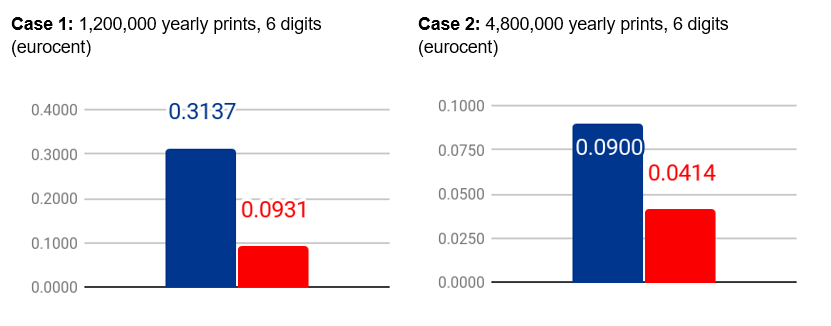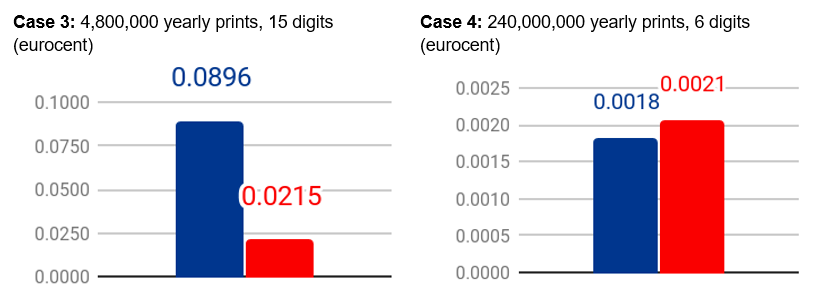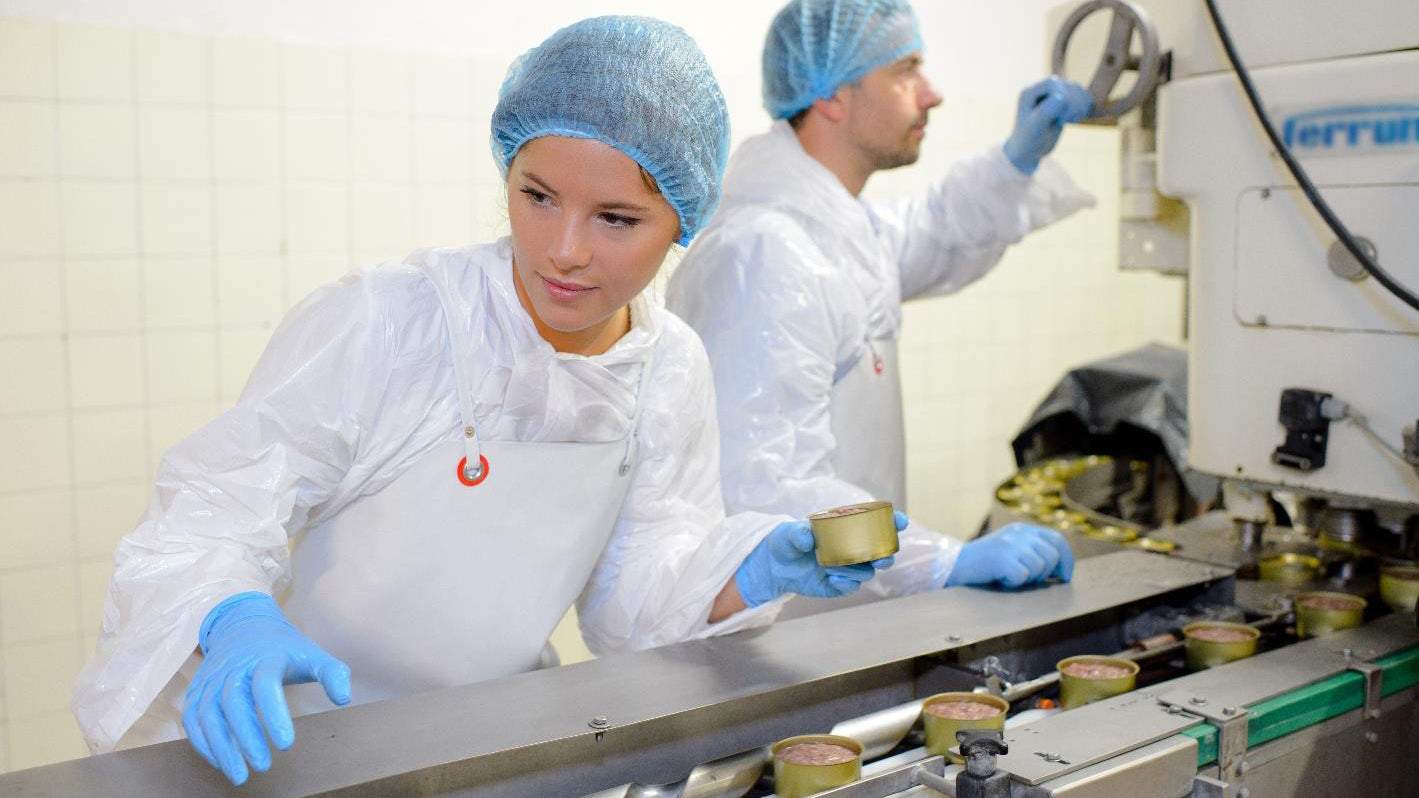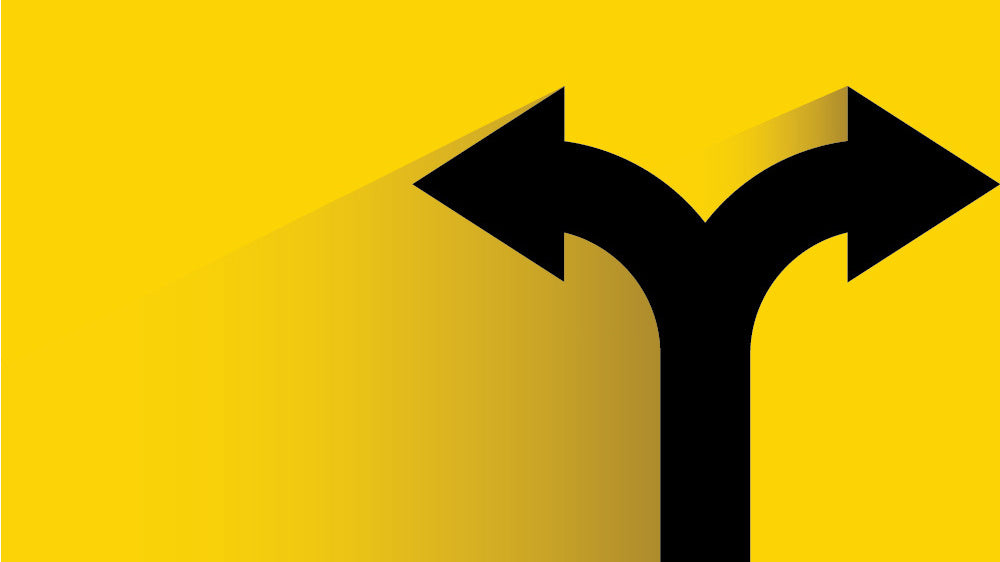But volume is not the only determining factor.
We have put together this guide to help you estimate your operating cost.
This guide takes into account all cost elements — from the capital investment to consumables — and it also factors in frequently omitted elements such as setup time and operation downtime.
The data comes from market research and from interviews we conducted with clients and prospects.
So, on to answer the question: Which of the two solutions - CIJ or TIJ - is more cost effective?
Basic assumptions for our calculations
We are limiting our possible scenarios to the following two basic assumptions
- We are printing a small code (5mm height) on a non-porous surface (e.g. plastic or glass) in standard text thickness:

- We are adding up total cost (Capex, opex, maintenance cost and hidden cost) across five years, which is a reasonable life expectancy for the equipment in question.
Cost components
1. CAPITAL EXPENSES
You need to purchase the asset and depreciate it.
The CIJ solutions our clients used and prospects currently use cost between €8,000 - €15,000. Therefore, we assume an average cost of €11,500, which includes the typical accessories that come along with CIJ printers.
The TIJ solution of choice, the edding in-line 12, costs €3,490.
2. CONSUMABLES
In the case of TIJ, this comes in the form of ink cartridges. Ink cost rise in line with number of prints.
With CIJ, it gets a bit more complicated as you have to take into account three materials: Ink, makeup and solvent:
With ink, it’s clear: tiny droplets of it stick to an object and make letters and numbers appear. Ink cost rise linearly with the number of prints, and on a unit level, are determined by the total amount of ink area covered, which itself is a function of:
- How many characters get printed
- How large the font size is
- And how thick the characters are
Makeup is a thinner contained inside the CIJ apparatus. A sensor measures the level of viscosity of the ink every two minutes, and if the ink is too thick, a bit of makeup is injected.
Solvent is essentially the same material as Makeup. It is stored outside the CIJ apparatus and used occasionally to manually clean the printhead. Its usage depends on the number of shifts you’re running. The more often you power the printer setup up and down, the more solvent you will use.
So what are the actual figures? Based on the conversations with our clients and prospects and doing some market research, we have created four scenarios for different businesses:
- Case 1 is a low-volume high-end cosmetics producer, printing a six-digit lot number on 10 items per minute in a 1-shift environment. This results in 1.2m yearly units.
- Case 2 is a mid-sized snack producer who prints a six-digit expiry date on 20 items per minute in a 2-shift environment. This results in 4.8m yearly units.
- Case 3 is a mid-sized pharma company who print 15 digits (lot and expiry date) on 20 items per minute in 2 shifts — 4.8m yearly units.
- Case 4 is a bottling plant printing a six-digit best-before date on 1,000 units per minute in a 2-shift environment — 240m yearly units.
Here is the summary of all variable cost in EuroCent:

From the above table you can derive two key insights:
With TIJ, there’s no economies of scale in variable cost, irrespective of the number of prints. With CIJ, costs fall dramatically with scale, down from 4,283 to 87 when you get into the hundreds of millions prins per year.
The main cost driver in CIJ is makeup, not ink. Look how in Case 4, makeup cost per print is 1% that of makeup cost per print in Case 1. As makeup depends on the time the printer is running, you want to distribute it across as many prints as possible. And this is the main reason why CIJ is more economical at very high throughput rates.
3. MAINTENANCE
Most CIJ solutions we have heard of have the first year’s worth of service included in the purchase price. Thereafter, the average yearly servicing cost is €810 (years 2-5).
TIJ printers such as the edding compact series are designed to not require any servicing. Most cases of “something not working” can be resolved by changing the ink cartridge. Also, during the first two years of operations, edding Tech will take care of any such related cost (except user error). Assuming a low probability of malfunction, we are generously assuming an average cost of €200 (years 3-5).
4. HIDDEN COST
Then there are hidden cost which affect CIJ solutions (but not TIJ):
4a. Installation & Training cost
CIJ printers can take up to a day to install and calibrate for mass production, as well as train staff in its usage. In our calculations, we assume one day of installation and training time. At an experienced production line manager’s average salary of €50,000, this is a one-off cost of €213. To not have to account for TIJ printer installation (a few minutes) and training (it’s so intuitive that it’s also a matter of minutes), we are reducing this figure to €200 and assume 0 for TIJ printers.
Now, are there additional cost the CIJ solution providers charge for installation and training? We don’t have any data on this, so we will follow the practice our technology partner Elried applies: €400 training and installation cost for CIJ solutions (because of their complexity), free for TIJ (since the written instructions are simple enough to follow, and the product is very intuitive to use).
4b. Downtime cost
Besides scheduled servicing (as mentioned above), non-scheduled servicing needs to be performed when the printer has been turned off for 20 minutes or more and ink has dried in the mechanical parts. But even shorter switch-off times result in unwanted downtimes as it takes several minutes to start a CIJ printer up again. And faults are more frequent with CIJ because of the many moving parts.
In contrast, TIJ printers are up and running instantly. They don’t need cleaning, and they don’t need scheduled maintenance. A failure can often be fixed by changing the cartridge, which doesn’t require specialist knowledge. This is important because it dramatically reduces downtime. Whoever is nearby during a failure can fix the situation immediately, without needing to wait for an expert technician.
As a result, we have (conservatively) calculated an average 95% uptime for CIJ printers.
For edding compact printers (TIJ), while we would like to confidently proclaim a 100% uptime, realistically we need to account for malfunctions and therefore assume a 99% uptime.
We are not including the likelihood of the solution to break to a point where it has to be replaced. We don’t have enough data on this, and so we assume that both CIJ and edding compact printers are equally (un)likely to require a sudden, unexpected, complete write-off.
Cost components - summary
The above figures and assumptions in a handy table:

Cost Summary
So if we add all the above numbers into a 5-year time frame, what are the results? Which solution is better in which scenario?
These are our results - the numbers show total cost (eurocent) in a 5-year horizon divided by the number of prints. All prints 5mm, standard thickness



This example shows that at very high numbers, CIJ is far cheaper than a TIJ solution.
But there is a kicker: It actually IS possible to reduce cost so that, even at extremely high print numbers, TIJ remains competitive.
Remember how in the assumptions, we mentioned that the prints are at standard thickness:

What would change if we reduced it to a thickness that minimises cost while maintaining legibility?

In this scenario, ink cost would drop by 93%, which would make a huge impact on our modelling. Remember, as ink is only a minor variable cost component in CIJ, the decrease in ink usage wouldn’t make much of a difference here. All the bigger is the impact on TIJ - see for yourself:



With thinner print, even the 240m / year scenario makes TIJ only marginally more costly. Given how much easier and hassle-free TIJ is, you may want to opt for TIJ even in high-volume scenarios. The only limitation is the speed of the solution. As mentioned in our CIJ vs TIJ blog post, TIJ can only print at 100 meters per minute.
At what volume level are the cost roughly the same?
A final interesting question arises about the level at which both cost curves meet, meaning at which volume level cost are the same on a 5-year horizon.
We have taken the above data points and run a regression on them.
In the standard print scenario, the cost are the same at roughly 60m prints per year, meaning: Until 60m prints per year, it’s cheaper to use TIJ, beyond that it’s cheaper to use CIJ:

And in the thin print scenario, this number rises to roughly 170m:

Conclusion
We hope this will help you in your decision-making about which technology to choose.
Contact us here if you would like us to calculate your specific case.







